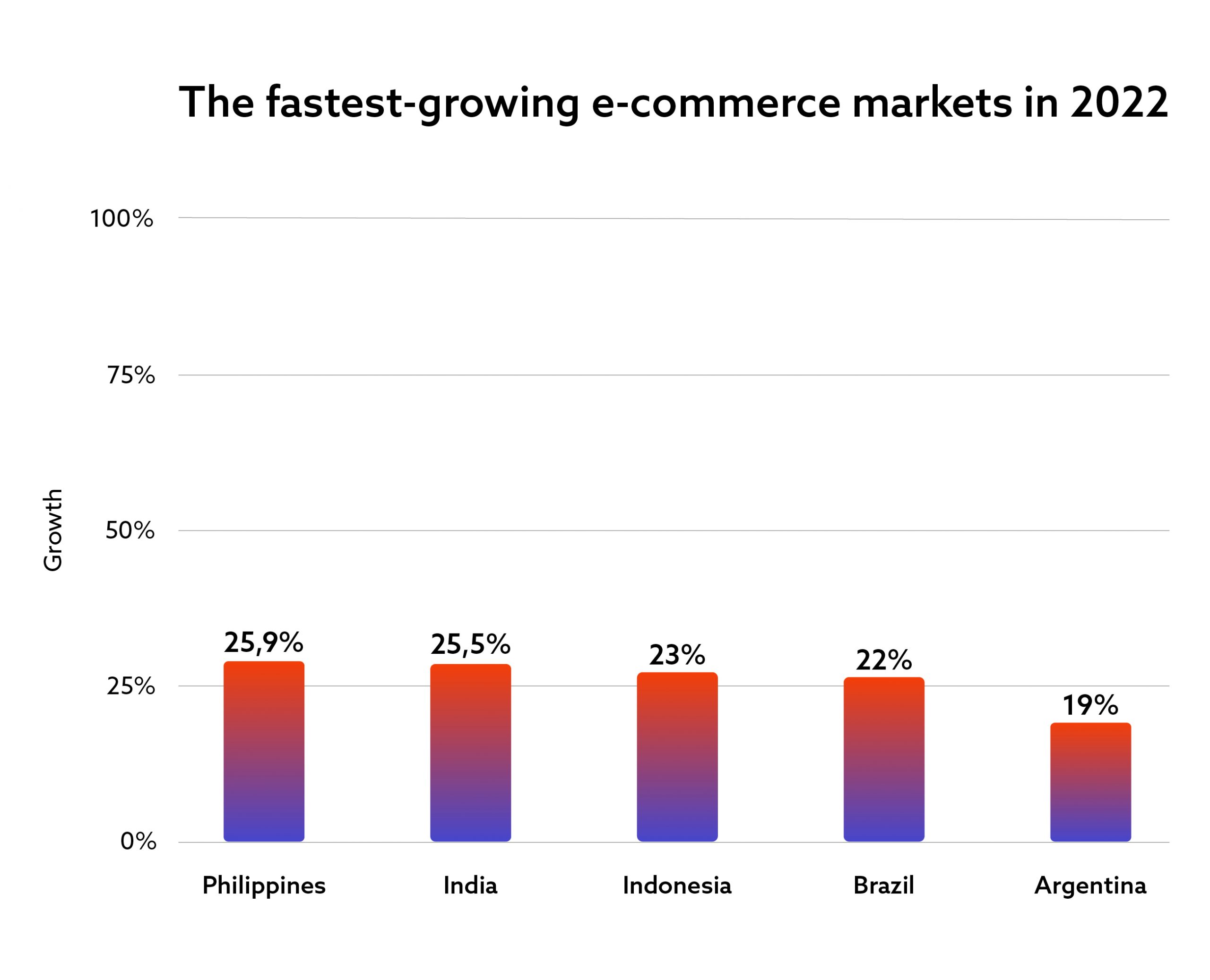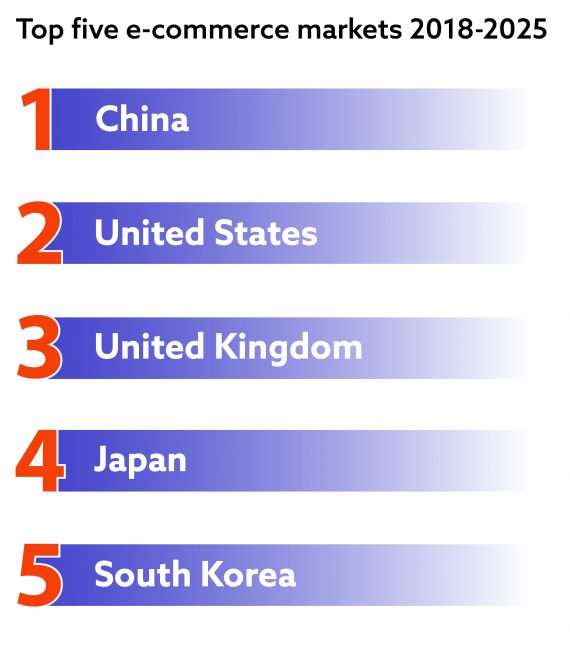The state of global ecommerce: what trends to look out for in 2022/2023?
If you’re planning to open or expand an ecommerce business, you need to find answers to questions, such as: What countries would be the best target? How to adjust your online shop to international buyers and gain their loyalty? Or how to leverage the latest technology solutions to stay ahead of the competitors?
You’ve come to the right place. In this article prepared in cooperation with Cezary Kożon, the CEO of Spyrosoft eCommerce, we’re analysing the global ecommerce market and some of the trends that have emerged or got into full swing this year. Read to find out what to expect and how to prepare your ecommerce business for the near future.
How big is the global ecommerce market?
In recent years, more and more retail and B2B businesses have moved towards an omnichannel strategy and have opened online stores to maximise their business potential. The Covid-19 pandemic has accelerated this trend, but one of the causes were also growing customer expectations as customers began to discover more convenience in online shopping on all levels.
Last year, the percentage of consumers who shopped online at least once grew to 74% of the total population in the US, 81% in the UK and 69% in China. Given the growing number of customers interested in online shopping, the revenue in the ecommerce market is projected to reach US $4.15tn in 2022. The number of users is expected to amount to 4,877.0m users by 2025.
Ecommerce has become an important branch of global retail. In 2015 it accounted for 7.4% of total retail sales worldwide, while in 2021, it reached 19.6%. Forecasts done by Statista indicate that by 2025, ecommerce would make up almost a quarter of total global retail sales.
The ecommerce path is mandatory and necessary in your business growth strategy, however, the right plan of action is key to achieving success. Let’s now look at what countries have the biggest potential for your ecommerce business to flourish.
What are the largest and fastest-growing ecommerce markets?

According to the forecast for 2022, the highest ecommerce sales growth will be noticed in Asia and the Americas. Philippines, India and Indonesia are expected to be the leaders with 25.9%, 25.5% and 23% growth, respectively. Asia-Pacific is by far the largest market for online retail. In 2021 ecommerce sales amounted to $2.992 trillion – that’s more than three times greater than in North America and nearly five times greater than in Europe.
Brazil and Argentina are most likely to be the fastest-growing ecommerce countries in the Americas, with a 22% and 19% increase. Last year, Latin America noted $85 billion in ecommerce sales, that’s an increase by a quarter in comparison to 2020.
China, for a few years now, remains the world’s leading ecommerce market. The number of online buyers, almost $824.5 million, and their collective buying power will most likely secure China’s leadership in the global ecommerce sector for the foreseeable future.
The US ecommerce sector is predicted to exceed $875 billion in 2022 – that’s slightly over one-third of China’s. The UK took third place in the ecommerce sales share in 2021, constituting 4.8% of total worldwide retail ecommerce.

China, the US, the UK, Japan and South Korea have been the top five ecommerce markets since 2018 and, according to Emarketer’s forecast, they’ll lead the way through to 2025.
What are the ecommerce trends to look out for in 2022?
Given the growth of the global ecommerce sector, keeping abreast of what is happening in the industry is necessary to stay competitive and not miss any opportunity. Below we’ve put together a list of the key trends, discussing the possible challenges that can be encountered and explaining how they can be tackled.
Trend #1: Global expansion
Many companies experience growth limitations as their domestic market is becoming more and more saturated. In order to find new growth opportunities, an increasing number of ecommerce brands are considering global expansion.
However, that may be a bumpy road if no strategy is developed and thorough preparation isn’t done beforehand. Ecommerce businesses that want to expand to foreign markets should consider rebuilding and adjusting their online shops to meet the demands and preferences of international buyers.
For example, it should be decided what additional payment methods, if any, should be added at the checkout step based on the target market research. Another step could be adding multilanguage versions of the website and listing the products in local currencies. A more advanced step would be to build different websites designed for different markets, using local domain names. Sometimes, the product strategies developed for one market may not necessarily work out for another. A targeted website gives more flexibility in presenting the products in a way appealing to a certain group of customers.
“One of the ways to diversify revenue stream is to enter a marketplace or, better to say, marketplaces. The current state of ecommerce sales shows precisely that there is no running from marketplaces (maybe with the exception of big brands), especially when considering entering a foreign market. 41% of all online spending globally is via marketplaces. The initial cost of entry will be much lower than establishing a full-fledged ecommerce operation with acquiring new traffic and covering logistics.“
Cezary Kożon – CEO of Spyrosoft eCommerce
Trend #2: Fostering long-term relationships with customers
As there are fewer barriers to entry, more and more retailers go online. The competition in online retail is becoming fierce. In order to stay afloat, ecommerce businesses must gain and maintain buyers’ loyalty.
To strengthen customer loyalty, ecommerce businesses should give buyers a holistic, personalised shopping experience. To do that, businesses must better understand their customer needs and address them more quickly. This may be possible only if organisations have insight into customer behavioural data from all sales channels under one system. Based on this information, ecommerce brands will be able to suggest personalised product recommendations and custom-tailored special offers to their customers.
“Ecommerce Businesses that were based solely on acquiring new traffic to increase sales will need to shift their strategy to the retention and increasing cLTV. The ROI on a single purchase from a new Customer is in the red, which strengthens the need to make the Customer base loyal by providing new offerings and complementary sales. The tools to support this trend will see a significant rise in popularity and increased complexity to deliver the results.”
Cezary Kożon – CEO of Spyrosoft eCommerce
Trend #3: Mobile shopping
The mobile ecommerce trend, also known as M-commerce, is still on the rise since the outbreak of the pandemic and there are no signs of it slowing down. According to Shopify, 71% of online sales on their platform in 2021 were made via mobile. An increase in the global use of smartphones and tablets, technological advances like shopping apps and more and more common access to 5G wireless network supports this trend. Shopify reports that one in five US shoppers uses mobile shopping apps multiple times per day. In 2022, mobile ecommerce sales are forecasted to pass $432 billion, up from $148 billion in 2018.
Given these numbers, mobile ecommerce is an important growth opportunity. To take advantage of it, ecommerce brands should include developing their own mobile apps in their growth strategy for 2022 and further years.
“To address this trend, ecommerce must be prepared not only to have a mobile app, but also a desktop version in PWA that will support mobile users. PWA allows for a smooth and fast ecommerce experience even with limited access to the Internet. On top of that, it ensures proper positioning for Google robots that check Manifest and page speed – aiming to make the site more visible in Google search results.”
Cezary Kożon – CEO of Spyrosoft eCommerce
Trend #4 Significant slowdown in sales growth dynamic
Inflation levels that are unprecedented – following the influx of cash during the COVID-19 pandemic, logistic problems and delays, resources scarcity and war in Ukraine – will leave consumers with less money at their disposal, translating into lower sales levels. Ecommerce will not avoid this trend, which was already visible in April 2022, when the YoY transaction volume in the US dropped by 1,8%, according to Mastercard SpendingPulse. This means that each and every conversion point will be worth even more. Operational excellency followed by software reliability will be the key focus for Ecommerce Directors.
We’ll help you build or expand your ecommerce business
Our consultants will help you define clear objectives and formulate the best approach to meet these goals. We believe in working as if we are part of your team to deliver web experiences that increase sales and generate a healthy ROI.
We’ll help you create outstanding customer experiences using best-in-class platforms, tailored to match your business requirements and budget, such as Magento, Commercetools, Shopware, Salesforce Commerce or Big Commerce. Our team of experts have many years of experience in building ecommerce solutions and integrating them with existing business software and systems.
Visit our ecommerce offering page for more information or contact our expert directly via the contact form below.
About the author
CONTACT US




